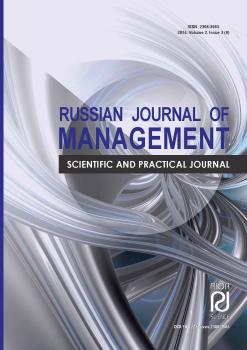Through a situational approach to strategic management of regional and urban development it is possible to identify the interaction between the managerial process and mechanism; to bring together the spatial and activity-related concepts of territorial development; and to explain the phenomenon in question from both general and specific perspectives. Territorial development is becoming the principal object of strategic management of a region or a city, its key tool being the utilization of its own good practices. The main objective of territorial development is increasing the capacity for constructive interaction between all its “actors and factors”. In this situation, monitoring of territorial development is seen as an integral part of management. It ensures the inventory, observation, and comparison of various trends determining the situation, as well as the results of actions aimed at its targeted alteration. Monitoring helps not only to promptly identify threats, but also to detect the opportunities for developing the situation in the desired directions within the “natural” trends of its dynamics. The situational approach to the monitoring of regional and urban development presented in the article was implemented in the development of the Strategy for the Socioeconomic Development of the City of Moscow until 2015 (as commissioned by the Department of Economic Policy and Development of the Government of Moscow) by an international team headed by the experts of Russian Presidential Academy of National Economy and Public Administration and Higher School of Economics.
region, city, territorial development, strategy, monito ring, objective tree, life cycle.
Опыт последнего десятилетия разработки и реализации многочисленных стратегий территориального развития в России и его сравнение с практикой ЕС [4, а также 1–3] выявляет значительный потенциал воздействия целенаправленной социально-экономической политики региональных и городских властей на результаты развития соответствующих территориальных образований. Вместе с тем этот опыт наглядно демонстрирует, что у этих властей в одиночку не хватает ресурсов и инструментов, достаточных для решения стратегических задач на уровне современных требований. Реальный успех приносит только способность обеспечить взаимодействие и консолидацию усилий многих заинтересованных сторон (в том числе на уровне конкретного государства и государств иностранных) на решении четко сформулированных и измеримых целей.
Достижение этих целей должно обеспечить новый, более высокий уровень конкурентоспособности региона или города по качеству жизни и человеческого капитала, качеству товаров и услуг, качеству среды, в том числе деловой, качеству экономического роста. Все это, в свою очередь, требует нового качества управления — развития инструментов и компетенций управления «целостной» ситуацией территориального развития, а не ее отдельными (ведомственно закрепленными) «фрагментами». Ситуация территориального развития становится основным объектом стратегического управления регионом или городом, использование позитивных аспектов ее динамики — его важнейшим инструментом, а формирование и использование потенциала конструктивного взаимодействия всего многообразия «акторов и факторов» территориального развития, способных изменить ситуацию в целевом направлении, — его основной задачей.
1. Atkinson R. Evroremont gradostroitel'noy politiki. Territoriya i planirovanie. 2010. № 2 (26). S. 21-29.
2. Zhitkov V.A., Labrents B.V., Rozental' V.O. Regional'nye strategii: praktika razrabotki i napravleniya sovershenstvovaniya. Ekonomika megapolisov i regionov. 2011. Vyp. 4 (40). S. 22-33.
3. Savchenko A.B. O khode rabot nad Strategiey sotsial'no-ekonomicheskogo razvitiya goroda Moskvy na period do 2025 goda. Ekonomika megapolisov i regionov. 2012. Vyp. 1 (43). S. 36-43.
4. Strategicheskoe planirovanie v regionakh i gorodakh Rossii: resursy dlya razvitiya. Doklady uchastnikov yubileynogo Kh Obshcherossiyskogo foruma liderov strategicheskogo planirovaniya (Sankt-Peterburg, 17-19 oktyabrya 2011 g.) / Pod red. E.S. Zhikharevicha. SPb.: Leont'evskiy tsentr, 2012. 152 s.
5. Global City Indicators Facility (2011). URL: www.cityindicators.org/Default.aspx.
6. Parnreiter C. Megacities in the Geography of Economic Governance. Die Erde. 2009. Vol. 140. № 4. P. 371-390.
7. Taylor P.J. Specification of the World Cities Network. Geographical Analysis. 2001. № 2. P. 181-194.
8. The Economist. World in Figures 2011. URL: http://www.economist.com/theworldin/2011.
9. Urban Indicators Guidelines (2004). Monitoring Habitat Agenda and Millennium Development Goals. United Nations Human Settlements Programme.














